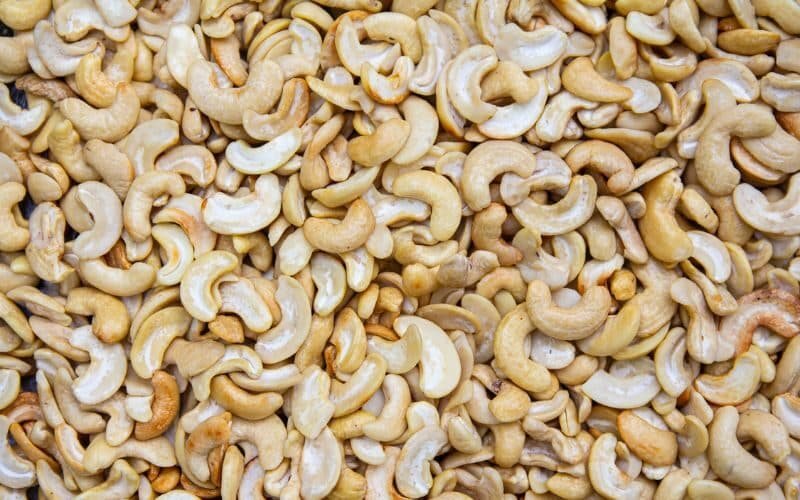Cashews rank among the most popular nuts on the market, primarily due to their soft, chewy, and creamy texture. If not approached with caution, a whole bag of them can be consumed in one sitting.
However, their allure isn’t solely for indulgence. Cashew nuts possess a nutrient-rich composition, the ability to stimulate saliva production, and a specific acid, all of which have the potential to hinder tooth decay and aid in the remineralization of tooth enamel.
This article examines how cashews prevent cavities and tooth decay while also addressing some of the leading causes of tooth decay.
How may cashews prevent tooth decay and cavities?
Cashews offer numerous health-protective benefits, yet we want to uncover the role that cashews play in the prevention and reversal of tooth decay.
Acids in cashew nuts kill bacteria
One of the ways cashew nuts may contribute to preventing tooth decay is through the presence of anacardic acid found in them.
Anacardic acid has been found to have potential uses in treating various medical conditions, including fighting infectious abscesses (1) and combating cancer by targeting free radicals (2), as well as demonstrating effectiveness in killing hormone-sensitive breast cancer cells (3). However, we will be focusing on its potential role in battling the bacteria responsible for causing tooth decay.
Anacardic acids can eliminate gram-positive bacteria, which play a role in tooth decay. Remarkably, a solution containing as little as one part anacardic acid in 200,000 parts water, or even one part in 2,000,000, can prove lethal to gram-positive bacteria within just 15 minutes. (4)
Another study highlighted that anacardic acid present in cashew nuts can help reduce dentine erosion. (5)
Dentine erosion, in simple terms, occurs when the tough outer layer of your teeth, known as dentine, undergoes wear and softening. This can happen due to factors like consuming acidic foods and drinks, or due to stomach acids from conditions like acid reflux. When dentine erosion occurs, it can make your teeth more sensitive to hot, cold, or sweet things and might lead to cavities or other dental problems over time.
However, it’s important to note that some of these studies have taken place in a laboratory setting, and their real-world application is yet to be fully understood. Additionally, there are questions about whether cashew nuts contain sufficient anacardic acid to yield the benefits described above, as the shell and the fruit might contain more of this acid.
Nonetheless, don’t let these uncertainties deter you from enjoying the many benefits of indulging in some delicious cashews.
Nutrients in Cashews
Cashew nuts not only taste good but are also packed with vitamins and minerals, including calcium, magnesium, phosphorus, and vitamin D, all of which play an essential role in ensuring the health of your teeth.
For example, calcium constitutes the structure of our teeth, and its compounds contribute to the strength of enamel, the outer layer of your teeth that protects against erosion, decay, and temperature sensitivity.
Vitamin D plays a crucial role in the formation of healthy teeth, acts as a shield against dental caries, and facilitates the release of calcium into saliva for enamel mineralization. Moreover, it effectively delays the onset and progression of dental cavities.
A study conducted in 2021 revealed that children with dental caries exhibit lower vitamin D levels in their blood and reduced calcium levels in their saliva.
Furthermore, exercise caution when taking vitamin D supplements without magnesium, as this combination may result in soft enamel that is susceptible to the acids in the mouth, ultimately leading to tooth decay.
Cashews stimulate saliva
Cashews help stimulate saliva production in the mouth, a vital factor in maintaining oral health. On the other hand, a dry mouth can lead to the development of dental caries and oral infections.
Saliva safeguards oral health through various means:
- Dilution of sugars following food and drink consumption.
- Antimicrobial and cleansing actions that break down bacterial cell walls and hinder growth.
- Neutralization of acid production and regulation of plaque pH.
- Enamel remineralization using calcium and phosphates.
In healthy teeth, mineral loss is counteracted by saliva’s reparative mechanisms. When saliva pH drops, tooth enamel begins to dissolve. Conversely, higher pH levels prompt saliva’s calcium and phosphate ions to initiate the remineralization process. (6)
Stimulating saliva flow enhances the elimination of acids (and sugars), consequently elevating saliva pH and facilitating demineralization. (7)
Hence, thoroughly masticating food, such as cashews, can prevent tooth decay and contribute to the remineralization of tooth enamel.
How much and how often should I consume cashews?
You’ve likely heard the saying that too much of anything is not good. The same goes for cashews. To reap its benefits, a mere handful of cashews a day is all you need.
You can enjoy these nuts in their raw or roasted form, making them an excellent post-meal snack.
Additionally, you can integrate them into your dietary regimen as cashew butter, utilize them for crafting salad dressings, or make use of them as an alternative milk for oatmeal or cereal.
It’s important to be mindful that certain cashew products may contain added salts, oils, and sugars. If you aim to minimize your intake of these additives, consider opting for raw or roasted unsalted cashews.
What are some of the causes of tooth decay?
Milk
Milk contains a natural sugar called lactose. Bacteria present in the mouth can feed on lactose and produce acids as a byproduct. These acids can erode the enamel, the protective outer layer of the teeth, leading to tooth decay over time.
Another intriguing fact is that countries with the highest dairy consumption also experience the highest rates of osteoporosis. (7) This could indicate a potential calcium deficiency within the body.
The theory posits that milk has an acidifying impact on the body’s pH, prompting a physiological response. Here’s the connection: calcium can act as a buffer to help maintain pH balance in the body, and the body’s primary reservoir of calcium happens to be, you guessed it, the bones.
Consequently, the very calcium crucial for maintaining bone strength is employed to counteract the acidifying influence of milk. As calcium is drawn from the bones, it eventually exits the body through urine, leading to an unexpected outcome: a genuine deficit of calcium.
Keep in mind, as of current research, we cannot definitively establish a direct cause. However, a substantial body of research has established a connection between dairy consumption and instances of calcium deficiency. (8)(9)
Processed sugar and foods
Sugary foods, especially those containing sucrose (table sugar), pose a significant threat to your dental health by providing a thriving environment for harmful bacteria.
A diet lacking essential nutrients can also contribute to tooth decay. Vitamins and minerals are crucial for maintaining robust teeth and bones. Processed sugars and foods, unfortunately, lack significant nutrients, potentially leading to periodontal disease and tooth loss.
It’s vital to consume foods in their whole form. During processing, refined grains and sugars are stripped away of essential nutrients needed for strong teeth. Opt for whole grains, whole foods, and natural sweeteners instead that contain nutrients to build and maintain healthy teeth.
Inadequate care
Tooth decay involves the deterioration of your teeth, potentially leading to cavities, dental abscesses, or even tooth loss. It stems from the actions of specific bacteria residing in dental plaque.
Plaque-dwelling bacteria can transform sugars from your diet into acids. Over time, if plaque accumulates, these acids can initiate harm to your teeth.
Hence, maintaining proper oral hygiene is crucial for averting tooth decay.
It is recommended that you:
- Floss once daily.
- Brush twice daily after meals.
- Replace your toothbrush every 3 to 4 months. If the bristles become worn down, bent, or broken, consider replacing them sooner.
Dry mouth
Dry mouth increases the likelihood of tooth decay, as saliva plays a crucial role in rinsing away food particles lingering in your mouth post-meals. In the absence of sufficient saliva, decay-causing bacteria flourish and dominate your oral environment.
A major contributor to dehydration is inadequate water intake. Ensure you’re consuming a suitable amount of water daily. A quick method to estimate your water requirement is by dividing your body weight by two, revealing the ounces you should aim for. To convert this figure to cups, divide by eight, as there are eight ounces in a cup.
In summary
Cashews offer more than just a delightful snack – they might play a role in thwarting tooth decay and promoting enamel remineralization due to their nutrient composition, saliva stimulation, and anacardic acid content.
Nonetheless, it’s crucial to maintain a healthy lifestyle and consume nutritious foods. While cashews can contribute to better oral health, it’s equally vital to avoid behaviors that initially lead to damage.
Sources
- Hollands, A., Corriden, R., Gysler, G., Dahesh, S., Olson, J., Raza Ali, S., Kunkel, M. T., Lin, A. E., Forli, S., Newton, A. C., Kumar, G. B., Nair, B. G., Perry, J. J. P., & Nizet, V. (2016). Natural Product Anacardic Acid from Cashew Nut Shells Stimulates Neutrophil Extracellular Trap Production and Bactericidal Activity. The Journal of biological chemistry, 291(27), 13964–13973. https://doi.org/10.1074/jbc.M115.695866
- Salehi, B., Gültekin-Özgüven, M., Kirkin, C., Özçelik, B., Morais-Braga, M. F. B., Carneiro, J. N. P., Bezerra, C. F., da Silva, T. G., Coutinho, H. D. M., Amina, B., Armstrong, L., Selamoglu, Z., Sevindik, M., Yousaf, Z., Sharifi-Rad, J., Muddathir, A. M., Devkota, H. P., Martorell, M., Jugran, A. K., Cho, W. C., … Martins, N. (2020). Antioxidant, Antimicrobial, and Anticancer Effects of Anacardium Plants: An Ethnopharmacological Perspective. Frontiers in endocrinology, 11, 295. https://doi.org/10.3389/fendo.2020.00295
- David J. Schultz, Nalinie S. Wickramasinghe, Margarita M. Ivanova, Susan M. Isaacs, Susan M. Dougherty, Yoannis Imbert-Fernandez, Albert R. Cunningham, Chunyuan Chen, Carolyn M. Klinge; Anacardic Acid Inhibits Estrogen Receptor α–DNA Binding and Reduces Target Gene Transcription and Breast Cancer Cell Proliferation. Mol Cancer Ther 1 March 2010; 9 (3): 594–605. https://doi.org/10.1158/1535-7163.MCT-09-0978
- Isao. Kubo, Hisae. Muroi, Masaki. Himejima, Yoshiro. Yamagiwa, Hiroyuki. Mera, Kimihiro. Tokushima, Shigeo. Ohta, and Tadao. Kamikawa. Structure-antibacterial activity relationships of anacardic acids. Journal of Agricultural and Food Chemistry 1993 41 (6), 1016-1019. https://doi.org/10.1021/jf00030a036
- Silveira, C., Oliveira, F., Dos Santos, M. L., de Freitas, T., Imparato, J. C., & Magalhães, A. C. (2014). Anacardic acid from brazilian cashew nut trees reduces dentine erosion. Caries research, 48(6), 549–556. https://doi.org/10.1159/000358400
- Dodds, M., Roland, S., Edgar, M., & Thornhill, M. (2015). Saliva A review of its role in maintaining oral health and preventing dental disease. BDJ Team, 2(1), 11-13. https://doi.org/10.1038/bdjteam.2015.123
- Dhanwal, D. K., Cooper, C., & Dennison, E. M. (2009). Geographic Variation in Osteoporotic Hip Fracture Incidence: The Growing Importance of Asian Influences in Coming Decades. Journal of Osteoporosis, 2010. https://doi.org/10.4061/2010/757102
- Cumming, R. G., & Klineberg, R. J. (1994). Case-control study of risk factors for hip fractures in the elderly. American journal of epidemiology, 139(5), 493–503. https://doi.org/10.1093/oxfordjournals.aje.a117032
- Bischoff-Ferrari, H. A., Dawson-Hughes, B., Baron, J. A., Burckhardt, P., Li, R., Spiegelman, D., Specker, B., Orav, J. E., Wong, J. B., Staehelin, H. B., O’Reilly, E., Kiel, D. P., & Willett, W. C. (2007). Calcium intake and hip fracture risk in men and women: a meta-analysis of prospective cohort studies and randomized controlled trials. The American journal of clinical nutrition, 86(6), 1780–1790. https://doi.org/10.1093/ajcn/86.5.1780







